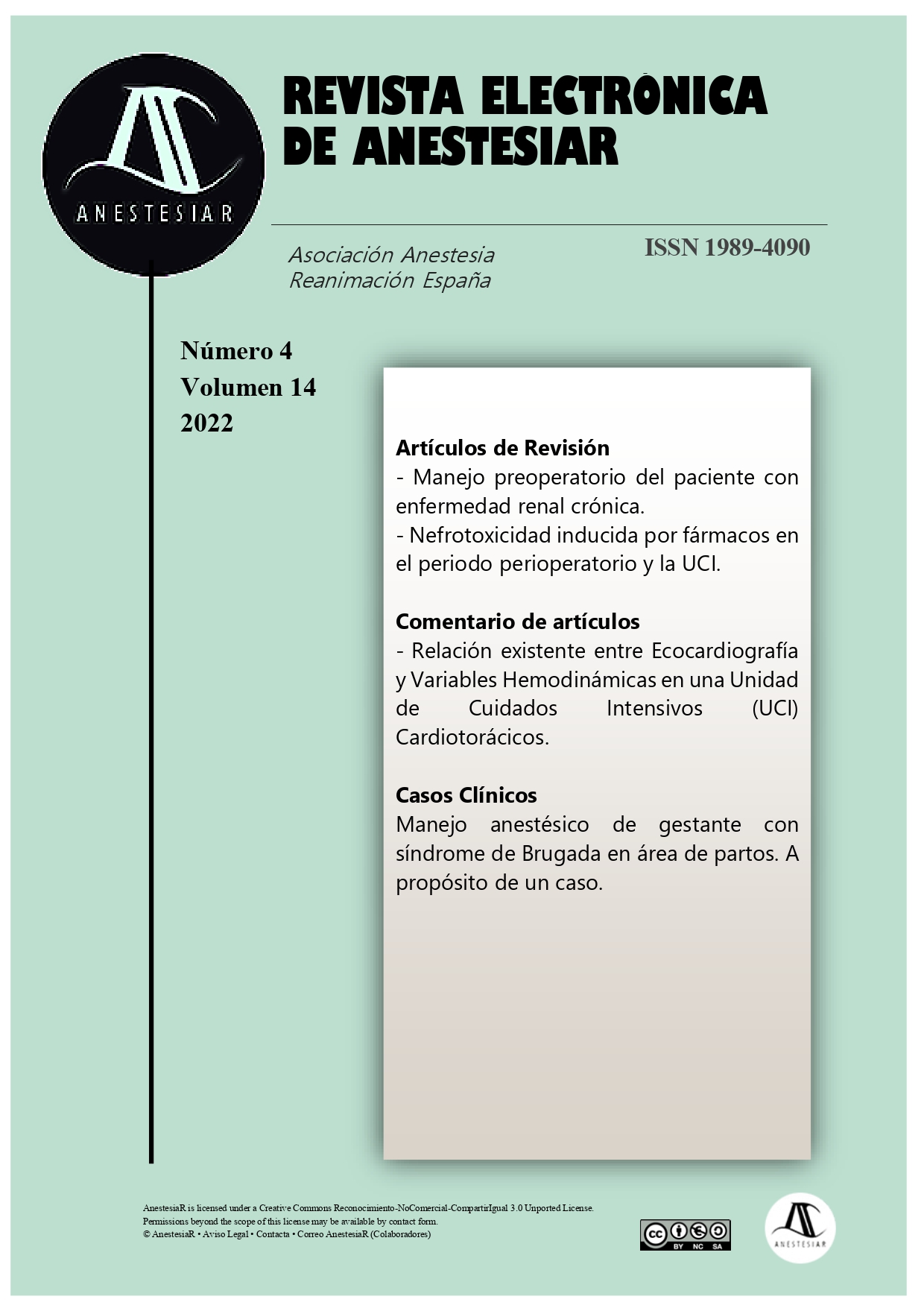Drug-induced nephrotoxicity in the perioperative period and ICU
DOI:
https://doi.org/10.30445/rear.v14i4.1007Keywords:
drugs, anesthetics, nephrotoxicityAbstract
Nephrotoxicity is defined as any kidney injury caused directly or indirectly by drugs, clinically depicted as acute renal failure, tubulopathy or glomerulopathy. Kidney damage can be preventable by knowing the drugs used in the perioperative period and intensive care unit. Pillars of nephrotoxic kidney damage management include reducing renal exposure to the toxic agent, correcting hydroelectrolytic disorders or hypovolemia, serum level determination, avoiding combinations of drugs from synergistically producing kidney damage, and trying to find therapeutic alternatives. This review aims to analyze alterations in renal function that can be caused by drugs used by anesthesiologists in their usual clinical practice. Thus, knowing these nephrotoxic drugs, the anesthesiologist will be able to detect early the renal impact of their administration and reduce the incidence of adverse effects. For the preparation of this review a bibliographic search was carried out in Pubmed and Medline with the following strategy: (Nephrotoxicity OR toxicity) AND (acute renal injury OR CRRT) AND (drugs OR anesthetics). Isolated clinical cases or articles not published in English or Spanish, as well as bibliography with a publication date prior to 1990, were excluded.
References
Kane-Gill SL, Goldstein SL. Drug-induced acute kidney injury: a focus on risk assessment for prevention. Crit Care Clin. 2015;31(4):675-84.
Perazella MA. Pharmacology behind common drug nephrotoxicities. Clin J Am Soc Nephrol. 2018;13(12):1897-908.
Awdishu L, Mehta RL. The 6R’s of drug induced nephrotoxicity. BMC Nephrol. 2017;18(1):124.
Griffin BR, Faubel S, Edelstein CL. Biomarkers of drug-induced kidney toxicity. Ther Drug Monit. 2019;41(2):213-26.
Caires RA, Silva VT, Burdmann E, Coelho FO, Costalonga EC. Drug-induced acute kidney injury. In: Ronco C, Bellomo R, Kellum JA, Ricci Z, eds. Critical care nephrology. 3rd ed. Philadelphia: Elsevier; 2019. p.214-21.
Conzen PF, Kharasch ED, Czerner SF, Artru AA, Reichle FM, Michalowski P, Rooke GA, Weiss BM, Ebert TJ. Low-flow sevoflurane compared with low-flow isoflurane anesthesia in patients with stable renal insufficiency. Anesthesiol 2002; 97: 578-84.
Withington DE, Decell MK, Al Ayed T. A case of propofol toxicity: further evidence for a causal mechanism. Paediatr Anaesth 2004; 14: 505-8.
Lee HT, Xu H, Siegel CD, Krichevsky IE. Local anesthetics induce human renal cell apoptosis. Am J Nephrol 2003; 23: 129-39.
Tuncer S, Bariskaner H, Yosunkaya A, Kilic M, Dogan N, Otel- cioglu S. [The effects of sufentanyl and remifentanyl in the iso- lated perfused rat kidney]. Agri 2004; 16: 56-61.
Della Rocca G, Pompei L, Coccia C, Costa MG, Cecchini V, Vilardi V, Pietropaoli P. Atracurium, cisatracurium, vecuronium and rocuronium in patients with renal failure. Minerva Anestesiol 2003; 69: 605-11, 612, 5.
Chuanyao T, James CE. Adrenergic Agonists α2. Med Clin North Am 1994; 1: 51.
Bolon M, Boulieu R, Flamens C, Paulus S, Bastien O. [Sedation induced by midazolam in intensive care: pharmacologic and pharmacokinetic aspects]. Ann Fr Anesth Reanim 2002; 21: 478-92.
Bakhriansyah M, Souverein PC, van den Hoogen MWF, de Boer A, Klungel OH. Risk of nephrotic syndrome for non-steroidal anti-inflammatory drug users. Clin J Am Soc Nephrol. 2019;14(9):1355-62.
Balci C, Uzun Ö, Arici M, Hayran SA, Yüce D, Ünal S. Nephrotoxicity of piperacillin-tazobactam combined with vancomycin: should it be a concern? Int J Antimicrob Agents. 2018;52(2):180-4.
Molitoris BA. Manifestations of and risk factors for amino- glycoside nephrotoxicity. UpToDate. 2017. Available from: https://www.uptodate.com/contents/ manifestations-of-and-risk-factors-for-aminoglycoside-nephrotoxicity.
Malyszko J, Kozlowska K, Kozlowski L, Malyszko J. Nephrotoxicity of anti- cancer treatment. Nephrol Dial Transplant. 2017;32(6):924-36.
Howard SC, McCormick J, Pui CH, Buddington RK, Harvey RD. Pre- venting and managing toxicities of high-dose methotrexate. Oncologist. 2016;21(12):1471-82.
Kidney Disease: Improving Global Outcomes (KDIGO) Acute Kidney Injury Work Group. KDIGO Clinical Practice Guideline for Acute Kidney Injury. Kidney Inter Suppl 2012;2(1):1-38.
RigattoMH, OliveiraMS, Perdigão-NetoLV, LevinAS, CarrilhoCM, Tanita MT, et al. Multicenter prospective cohort study of renal failure in patients treated with colistin versus polymyxin B. Antimicrob Agents Chemother. 2016;60(4):2443-9.
Cosyns JP, Jadoul M, Squifflet JP, Wese FX, Van Ypersele de Strihou C. Urothelial lesions in Chinese herbs nephropathy. Am J Kidney Dis 1999; 33:1011–1017.
Downloads
Published
How to Cite
Issue
Section
License
Copyright (c) 2022 Revista Electrónica AnestesiaR

This work is licensed under a Creative Commons Attribution-ShareAlike 4.0 International License.
 Envío y derechos de autor
Envío y derechos de autor


 Revista Electrónica AnestesiaR by
Revista Electrónica AnestesiaR by 